Related Research Articles

Pyotr Ilyich Tchaikovsky was a Russian composer of the Romantic period. He was the first Russian composer whose music would make a lasting impression internationally. Tchaikovsky wrote some of the most popular concert and theatrical music in the current classical repertoire, including the ballets Swan Lake and The Nutcracker, the 1812 Overture, his First Piano Concerto, Violin Concerto, the Romeo and Juliet Overture-Fantasy, several symphonies, and the opera Eugene Onegin.

Nikolai Andreyevich Rimsky-Korsakov was a Russian composer, a member of the group of composers known as The Five. He was a master of orchestration. His best-known orchestral compositions—Capriccio Espagnol, the Russian Easter Festival Overture, and the symphonic suite Scheherazade—are staples of the classical music repertoire, along with suites and excerpts from some of his 15 operas. Scheherazade is an example of his frequent use of fairy-tale and folk subjects.

The Five, also known as the Mighty Handful or The Mighty Five, were five prominent 19th-century Russian composers who worked together to create a distinct national style of classical music: Mily Balakirev, César Cui, Modest Mussorgsky, Nikolai Rimsky-Korsakov and Alexander Borodin. They lived in Saint Petersburg and collaborated from 1856 to 1870.

Mily Alexeyevich Balakirev was a Russian composer, pianist, and conductor known today primarily for his work promoting musical nationalism and his encouragement of more famous Russian composers, notably Pyotr Ilyich Tchaikovsky. He began his career as a pivotal figure, extending the fusion of traditional folk music and experimental classical music practices begun by composer Mikhail Glinka. In the process, Balakirev developed musical patterns that could express overt nationalistic feeling. After a nervous breakdown and consequent sabbatical, he returned to classical music but did not wield the same level of influence as before.

Sergey Ivanovich Taneyev was a Russian composer, pianist, teacher of composition, music theorist and author.
Romeo and Juliet, TH 42, ČW 39, is an orchestral work composed by Pyotr Ilyich Tchaikovsky. It is styled an Overture-Fantasy, and is based on Shakespeare's play of the same name. Like other composers such as Berlioz and Prokofiev, Tchaikovsky was deeply inspired by Shakespeare and wrote works based on The Tempest and Hamlet as well.

Manfred is a "Symphony in Four Scenes" in B minor by Pyotr Ilyich Tchaikovsky, his Opus 58, but unnumbered. It was written between May and September 1885 to a program based upon the 1817 poem of the same name by Byron, coming after the composer's Fourth Symphony and before his Fifth.
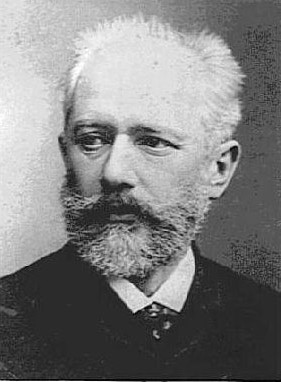
Pyotr Ilyich Tchaikovsky's Symphony No. 3 in D major, Op. 29, was written in 1875. He began it at Vladimir Shilovsky's estate at Ussovo on 5 June and finished on 1 August at Verbovka. Dedicated to Shilovsky, the work is unique in Tchaikovsky's symphonic output in two ways: it is the only one of his seven symphonies in a major key ; and it is the only one to contain five movements.
The Symphony No. 2 in C minor, Op. 17 by Pyotr Ilyich Tchaikovsky was composed in 1872. One of Tchaikovsky's joyful compositions, it was successful right from its premiere and also won the favor of the group of nationalistic Russian composers known as "The Five", led by Mily Balakirev. Because Tchaikovsky used three Ukrainian folk songs to great effect in this symphony, it was nicknamed the "Little Russian" by Nikolay Kashkin, a friend of the composer as well as a well-known musical critic in Moscow. Ukraine was at that time frequently called "Little Russia".

Pyotr Ilyich Tchaikovsky's Piano Concerto No. 3 in E-flat major was at first conceived by him as a symphony in the same key. But he abandoned that idea, jetisoned all but the planned first movement, and reworked this in 1893 as a one-movement Allegro brillante for piano and orchestra. His last completed work, it was duly published as Opus 75 the next year, after he died, but given by publisher Jurgenson the title "Concerto No. 3 pour Piano avec accompagnement d'Orchestre".
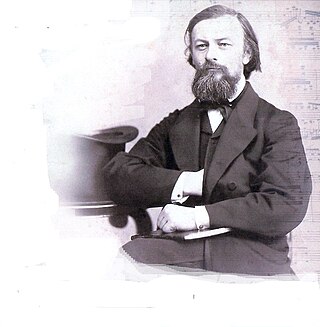
Nikolai or Nicolaus Ivanovich von Zaremba was a Russian musical theorist, teacher and composer. His most famous student was Pyotr Ilyich Tchaikovsky, who became his pupil in 1861. Others included Fyodor Dostoevsky's nephews, the children of his brother Mikhail and Vasily Safonov. Until 2010 almost nobody knew what he had composed.
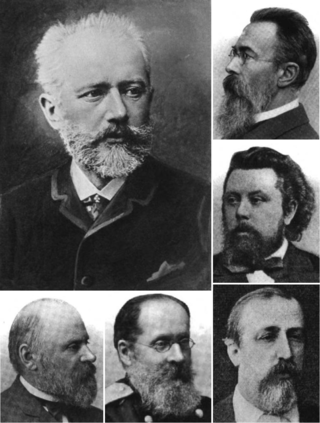
In mid- to late-19th-century Russia, Pyotr Ilyich Tchaikovsky and a group of composers known as The Five had differing opinions as to whether Russian classical music should be composed following Western or native practices. Tchaikovsky wanted to write professional compositions of such quality that they would stand up to Western scrutiny and thus transcend national barriers, yet remain distinctively Russian in melody, rhythm and other compositional characteristics. The Five, made up of composers Mily Balakirev, Alexander Borodin, César Cui, Modest Mussorgsky, and Nikolai Rimsky-Korsakov, sought to produce a specifically Russian kind of art music, rather than one that imitated older European music or relied on European-style conservatory training. While Tchaikovsky himself used folk songs in some of his works, for the most part he tried to follow Western practices of composition, especially in terms of tonality and tonal progression. Also, unlike Tchaikovsky, none of The Five were academically trained in composition; in fact, their leader, Balakirev, considered academicism a threat to musical imagination. Along with critic Vladimir Stasov, who supported The Five, Balakirev attacked relentlessly both the Saint Petersburg Conservatory, from which Tchaikovsky had graduated, and its founder Anton Rubinstein, orally and in print.

Antar is a composition for symphony orchestra in four movements by the Russian composer Nikolai Rimsky-Korsakov. He wrote the piece in 1868 but revised it in 1875 and 1891. He initially called the work his Symphony No. 2. He later reconsidered and called it a symphonic suite. It was first performed in March 1869 at a concert of the Russian Musical Society.

Nadezhda Nikolayevna Rimskaya-Korsakova was a Russian pianist and composer as well as the wife of composer Nikolai Rimsky-Korsakov. She was also the mother of Russian musicologist Andrey Rimsky-Korsakov.
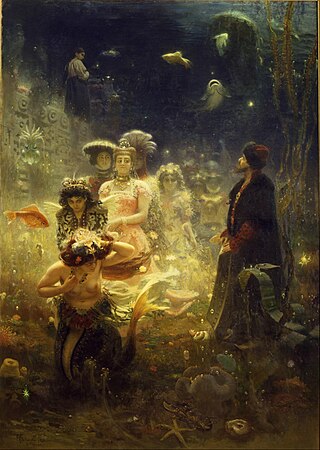
Sadko, Op. 5, is a Tableau musical, or Musical picture, by Nikolai Rimsky-Korsakov, written in 1867 and revised in 1869 and 1892. It is sometimes called the first symphonic poem written in Russia. It was first performed in 1867 at a concert of the Russian Musical Society (RMS), conducted by Mily Balakirev. Rimsky-Korsakov later wrote an opera of the same name which quotes freely from the earlier work. From the tone poem the composer quoted its most memorable passages in the opera, including the opening theme of the swelling sea, and other themes as leitmotifs – he himself set out to "utilize for this opera the material of my symphonic poem, and, in any event, to make use of its motives as leading motives for the opera".

Nikolai Rimsky-Korsakov composed his Symphony No. 1 in E minor, Op. 1, between 1861 and 1865 under the guidance of Mily Balakirev. Balakirev also premiered the work at a concert of the Free Music School in December 1865. Rimsky-Korsakov revised the work in 1884.
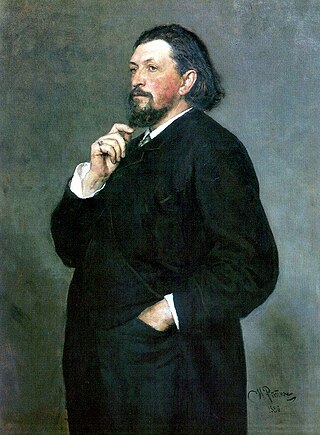
The Russian Symphony Concerts were a series of Russian classical music concerts hosted by timber magnate and musical philanthropist Mitrofan Belyayev in St. Petersburg as a forum for young Russian composers to have their orchestral works performed. While a number of works by these composers were performed, pieces written by composers of the previous generation such as Nikolai Rimsky-Korsakov and Mily Balakirev were also played there.

While the contributions of the Russian nationalistic group The Five were important in their own right in developing an independent Russian voice and consciousness in classical music, the compositions of Pyotr Ilyich Tchaikovsky became dominant in 19th century Russia, with Tchaikovsky becoming known both in and outside Russia as its greatest musical talent. His formal conservatory training allowed him to write works with Western-oriented attitudes and techniques, showcasing a wide range and breadth of technique from a poised "Classical" form simulating 18th century Rococo elegance to a style more characteristic of Russian nationalists or a musical idiom expressly to channel his own overwrought emotions.

Pyotr Ilyich Tchaikovsky's relations with the group of composers known as the Belyayev circle, which lasted from 1887 until Tchaikovsky's death in 1893, influenced all of their music and briefly helped shape the next generation of Russian composers. This group was named after timber merchant Mitrofan Belyayev, an amateur musician who became an influential music patron and publisher after he had taken an interest in Alexander Glazunov's work. By 1887, Tchaikovsky was firmly established as one of the leading composers in Russia. A favorite of Tsar Alexander III, he was widely regarded as a national treasure. He was in demand as a guest conductor in Russia and Western Europe, and in 1890 visited the United States in the same capacity. By contrast, the fortunes of the nationalistic group of composers known as The Five, which preceded the Belyayev circle, had waned, and the group had long since dispersed; of its members, only Nikolai Rimsky-Korsakov remained fully active as a composer. Now a professor of musical composition and orchestration at the Saint Petersburg Conservatory, Rimsky-Korsakov had become a firm believer in the Western-based compositional training that had been once frowned upon by the group.
References
- 1 2 3 4 Rimsky-Korsakov, My Musical Life, 71.
- ↑ Abraham, Gerald, ed. Stankey Sadie, The New Grove Dictionary of Music and Musicians, 20 vols. (London: Macmillan, 1980), vol. 16, 28.
- ↑ Rimsky-Korsakov, 73.
- 1 2 Brown, David, Tchaikovsky: The Early Years, 1840-1874 (New York: W.W. Norton & Company, 1978), 129-130.
- ↑ Brown, 130.
- ↑ Rimsky-Korsakov, 299.